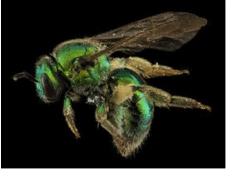As MCBA members, while we have a primary interest in the honeybee, the environment in which apis mellifera lives and makes honey for us is the same one in which thousands of other species of native bees pollinate and perpetuate a diverse variety of plants.
A few bee facts:
- There are 20,000 bee species
- There are 4,000 bee species in the U.S.
- There are 430 bee species in Maryland
- 90% of all bee species are solitary
- 10% are colonial (like the honeybees)
- 70% of species nest in the ground
So how are honeybees different from the other thousands of bee species? While they have much in common, apis mellifera has the following combination of factors that sets it apart:
- They have barbed stingers
- They have hair on the eye
- The males look different from female
- They progressively feed their larva (instead of sealing food in with the larva and leaving)
- They are cavity nesters (about 30% of bees nest in a cavity)
- They make honey (only bees that over winter make honey)
- They make and use comb
- They swarm
- They are polyandrous (queens mate with many different drones)
- They are colonial (live in groups)
- They have a corbicula (pollen basket)
- They do not hibernate or go into a period of dormancy
- They do the waggle dance to share information with hive mates
As Tim talked about each item on the list of differences, attendees were able to ask questions and better understand why each attribute is used by honeybees and how each species of bees uses its unique physical attributes to pollinate or derive benefit from the plants in which it specializes. It was a fascinating talk, illustrated with amazing photographs from the work Tim has done with bees in South America and as a volunteer in entomologist Dr. Sam Droege’s lab.
-Maureen Jais-Mick


